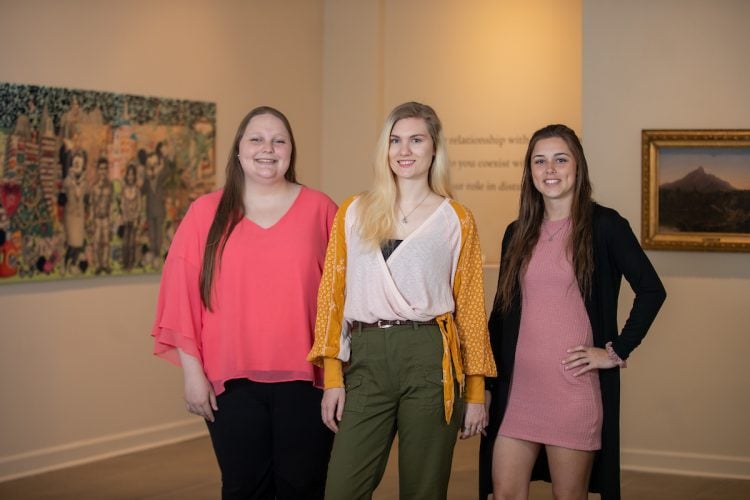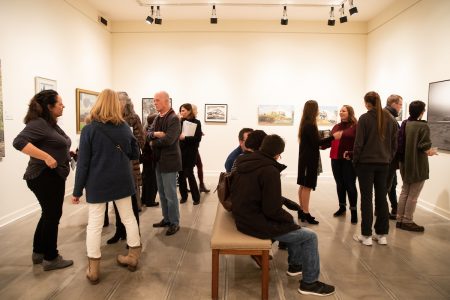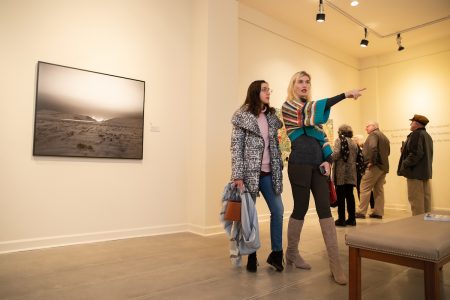Developed and Disturbed: Three students curate their own exhibition for museum and heritage studies course

(From left) Sara Primm, Elisabeth Ayars, and Jordon Kirkpatrick
Tasked with co-curating an exhibition on American landscape art for her Curatorial Seminar course, Elisabeth Ayars ’19 perused Randolph’s art collection for inspiration. Initially, she was searching for works that were similar and cohesive. But it was the differences between the works that really stood out.
“They were all made with different mediums, and they were all different types of landscapes from different time periods,” Ayars recalled. “So I thought instead of doing a show about how they’re the same, let’s do a show about how they’re different.”

Community members attend the opening for the exhibition at the Maier Museum of Art at Randolph College last spring
From there, Ayars and her classmates, Jordon Kirkpatrick ’19 and Sara Primm ’20, conceptualized and co-curated the exhibition, Developed and Disturbed: Visions of the American Landscape. On view through the summer, the exhibition examined how landscape art may reveal an increasing tension between nature and industry within the United States. It included works in a variety of media, from the 19th-century to the present, that addressed that tension in subtle and thought-provoking ways.
Each student focused on three themes in the exhibition: natural, coexistent, and industrial landscape. Ayars arranged the natural section, which featured scenes of undisturbed nature. Pieces included Two Birches by Rackstraw Downes and Corway Peak, New Hampshire, by her favorite artist,
Thomas Cole. He and his work were also the subject of her senior paper for art history.
“For a small school like Randolph to even have a painting by him is really impressive,” Ayars said. “A student being able to curate an exhibition with a Thomas Cole piece is unheard of in other places.”
For her section on coexistence, Kirkpatrick included pieces that demonstrated the gradual change in landscapes due to human intervention. Among the works included were Louise Jordan Smith’s Mountains from My Home and Fields and House.

Elisabeth Ayars points to a piece in the exhibition
“My favorite work in the exhibition was Running Horses by Thomas Hart Benton because it’s the perfect representation of both the flourishing natural landscape and the creeping of the developing world,” Kirkpatrick said. “This lithograph displayed three horses galloping across a field in the foreground. Beyond them, a train thundered along the horizon, almost unnoticeable as its smoke rose into the clouds until the two were nearly indistinguishable.”
Primm arranged the industrial section, which focused on urbanization and its effects on the natural world. It opened with Emmet Gowin’s photographs Limestone Quarry, Austin, Texas, and Sedan Crater, Northern End of Yucca Flat, Nevada Test Site, and closed with Sang-ah Choi’s Welcome to America. As she researched each piece, Primm enjoyed learning about the intentions of the artists and the messages they were trying to convey.
“It made me realize that I do care about the environment and made me think about how we are working to sustain it and what we can do to help,” Primm said.
As a history and museum and heritage studies double major, Primm was able to put her education and curating skills to the test.
“In this class, I got to pick the objects we exhibited and actually design an education plan to show how we’re educating people through these works of our landscape and history,” she said. “It was really a combination of the things I like—learning art history and educating the public about art.”
Tags: art, muhs, museum and heritage studies, Vita No. 7
